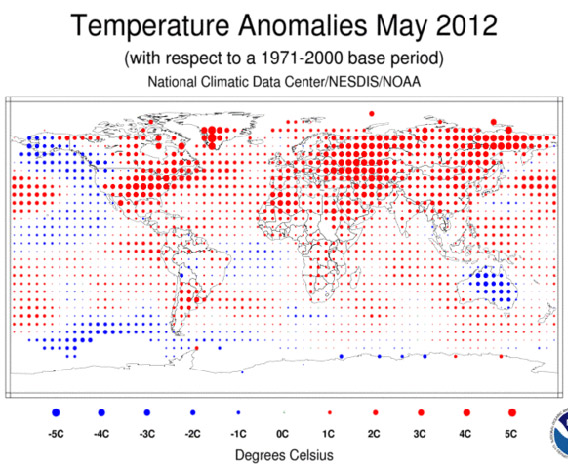
May 2012 temperatures as compared to 1971-2000 base. Graph courtesy of NOAA.
Last month was the second warmest May since record-keeping of global temperatures began 132 years ago. Globally, temperatures were 0.66 degrees Celsius (1.19 Fahrenheit) above the 20th Century Average and were only topped by May 2010, according to preliminary findings by the National Oceanic and Atmospheric Administration (NOAA).
If you live in the northern hemisphere, it was actually the warmest May on record with temperatures 0.85 degrees Celsius (1.53 degrees Fahrenheit) above average.
La Nina conditions, which generally bring cooler temperatures worldwide, have dissipated this spring causing scientists to predict an uptick in global temperatures. So far, 2012 is the 11th warmest year on record, but could rise even higher if global temperatures remain highly elevated.
Climate change is occurring worldwide due to burning fossil fuels, deforestation, industrial agriculture, and other human activities that result in the emissions of greenhouse gases. Since the early Twentieth Century, temperatures have risen approximately 0.8 degrees Celsius (1.44 degrees Fahrenheit) worldwide. Shockingly, the world hasn’t experienced a single year below the 20th Century average since 1975.
Governments around the world have pledged to keep global warming from rising above 2 degrees Celsius (3.6 degrees Fahrenheit), but have done little thus far to achieve that goal. The International Energy Agency (IEA) recently warned that unless greenhouse gas emissions were rapidly curtailed the world would warm 6 degrees Celsius (10.8 degrees Fahrenheit) by 2100.
“With the current policies in place, the world is perfectly on track to six degrees Celsius increasing the temperature, which is very bad news. And everybody, even school children, know this will have catastrophic implications for all of us,” the chief economist with the International Energy Agency, Faith Birol, recently said.
Related articles
Warmer forests expel carbon from soils creating “vicious cycle”

(06/13/2012) As the world warms, temperate forests could become a source of carbon dioxide emission rather than a sink according to a new study in the Proceedings of the National Academy of Sciences (PNAS). Scientists found that two forest sites in the U.S. (Wisconsin and North Carolina) emitted long-stored carbon from their soils when confronted with temperatures 10-20 degrees Fahrenheit (5.5-11.1 degrees Celsius) higher than average.
U.S. undergoes warmest spring on record
(06/12/2012) Spring in the U.S. was the warmest on record, beating the past record-year (1910), by a stunning two degrees Fahrenheit, according to new data from the National Oceanic and Atmospheric Administration (NOAA). The data also shows that the past 12 months–from June 2011 through May 2012–was the warmest on record in the contiguous U.S. as well.
As Colorado and New Mexico burn, scientists say prepare for more

(06/12/2012) A massive wildlife in Colorado still burns after it has killed one person and damaged or destroyed over a hundred structures. The fire, the third largest in Colorado’s history, has burned 39,500 acres (16,000 hectares) to date. Meanwhile in central New Mexico, another wildfire has damaged or destroyed 35 structures and burned 34,500 acres (14,000 hectares). This comes just weeks after New Mexico’s largest wildfire ever—still going—burned up over 247,000 acres (100,000 hectares) of the Gila Forest. Weeks of heroic efforts by thousands of firefighters have contained this megafire by only 37 percent to date. Now, a new scientific study in Ecospshere has found that North America and Europe must prepare for even more fires as global temperatures continue to rise from climate change.
As La Nina ends, world experiences 5th warmest April
(05/21/2012) La Nina conditions, which generally bring colder temperatures to many parts of the world, ended last month resulting in the fifth warmest April since record-keeping began, and the hottest April yet in the terrestrial Northern Hemisphere, according to the National Oceanic and Atmospheric Administration (NOAA).
U.S. undergoes warmest 12 months yet
(05/10/2012) Americans would not be remiss in asking, “is it getting hot in here?” According to new data from the National Oceanic and Atmospheric Administration (NOAA)’s National Climatic Data Center, the last twelve months (from May 2011 through April 2012) were the warmest on record for the lower 48 U.S. states since record keeping began in the late 19th Century.
U.S. suffers warmest March, breaking over 15,000 record temperatures
(04/11/2012) March was the warmest ever recorded in the U.S. with record-keeping going back to 1895, according to new data by the National Oceanic and Atmospheric Administration (NOAA). But the month wasn’t just a record-breaker, it was shockingly aberrant: an extreme heatwave throughout much of the eastern and central U.S. shattered 15,272 day and nighttime records across the U.S. In all March 2012 was 0.5 degrees Fahrenheit above the previous warmest March in 1910, and an astounding 8.6 degrees Fahrenheit above the 20th Century average for March in the U.S.







